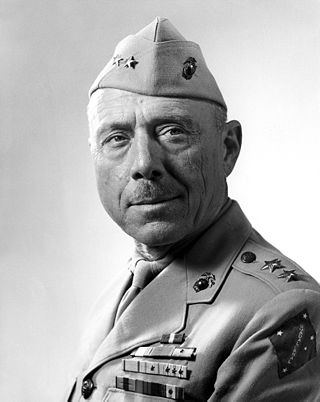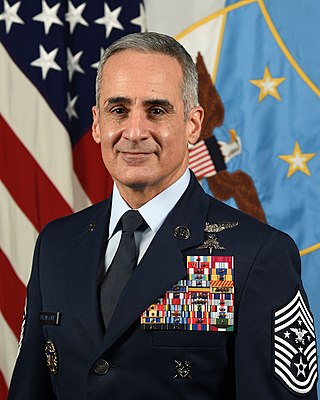Related Research Articles

The United States Air Force (USAF) is the air service branch of the United States Armed Forces, and is one of the eight uniformed services of the United States. Originally created on 1 August 1907, as a part of the United States Army Signal Corps, the USAF was established as a separate branch of the United States Armed Forces in 1947 with the enactment of the National Security Act of 1947. It is the second youngest branch of the United States Armed Forces and the fourth in order of precedence. The United States Air Force articulates its core missions as air supremacy, global integrated intelligence, surveillance and reconnaissance, rapid global mobility, global strike, and command and control.
Sergeant is a rank in use by the armed forces of many countries. It is also a police rank in some police services. The alternative spelling, serjeant, is used in The Rifles and other units that draw their heritage from the British light infantry. Its origin is the Latin serviens, 'one who serves', through the Old French term serjant.
The Ranger Creed is the official creed of the United States Army Rangers. The Ranger Creed was written in 1974 by CSM Neal R. Gentry, the original command sergeant major of the reactivated 1st Ranger Battalion. It was initiated by the Battalion Commander, then-LTC Kenneth C. Leuer, and re-drafted by the battalion XO, MAJ "Rock" Hudson and finalized at Fort Stewart, Georgia in 1974 when the original cadre deployed there on 1 July 1974. Today, members of Ranger community recite the Ranger Creed during formations, ceremonies, physical training activities and upon graduations from the Ranger Assessment and Selection Program (RASP) and the U.S. Army Ranger Course.
The chart below represents the current enlisted rank insignia of the United States Air Force.

The chief master sergeant of the Air Force is a unique non-commissioned rank in the United States Air Force. The holder of this rank and position of office represents the highest enlisted level of leadership in the Air Force, unless an enlisted airman is serving as the senior enlisted advisor to the chairman. The CMSAF provides direction for the enlisted corps and represents their interests, as appropriate, to the American public, and to those in all levels of government. The CMSAF is appointed by the Air Force chief of staff (AF/CC) and serves as the senior enlisted advisor to the Air Force chief of staff and the secretary of the Air Force on all issues regarding the welfare, readiness, morale, and proper utilization and progress of the enlisted force.
A Noncommissioned Officer Professional Development Ribbon is an award presented by the United States Army, Air Force, and Space Force to recognize those noncommissioned officers (NCOs) who have completed a prescribed leadership course at an NCO training school. The Navy, Marine Corps, and Coast Guard have no equivalent to the Noncommissioned Officer Development Ribbon.

Teed Michael "Buzz" Moseley is a retired United States Air Force general who served as the 18th Chief of Staff of the United States Air Force. He is a fighter pilot with more than 3,000 flight hours in fighters and trainers, most in the F-15 Eagle.

The Soldier's Creed is a standard by which all United States Army personnel are expected to live. All U.S. Army enlisted personnel are taught the Soldier's Creed during basic training, and recite the creed in public ceremonies at the conclusion of training. Both the Soldier's Creed and the Noncommissioned Officer's Creed are required knowledge at enlisted promotion boards to compete for the rank of sergeant and above, as well as 'Soldier of the Month' boards. It is also common practice to recite the Soldier's Creed at the graduation ceremony from Army ROTC. Unlike the U.S. Uniformed Services Oath of Office or the Oath of Enlistment, the Soldier's Creed is not a legally-binding oath and can be affirmed by both commissioned officers and enlisted soldiers.

The Rifleman's Creed is a part of basic United States Marine Corps doctrine. Major General William H. Rupertus wrote it during World War II following the attack on Pearl Harbor between late 1941 and early 1942, but its first publication was in San Diego in the Marine Corps Chevron on March 14, 1942. His reasoning for writing the Creed is believed to be that he felt that his men had to understand the concept "that the only weapon which stands between them and Death is the rifle...they must understand that their rifle is their life..."

The United States Air Force Honor Guard is the official ceremonial unit of the United States Air Force and is assigned to Joint Base Anacostia-Bolling, Washington D.C.
An Airman's Letter to His Mother is a 1941 documentary-style British propaganda short film directed by Michael Powell and narrated by John Gielgud and Powell.

The Battle of Takur Ghar was a short but intense military engagement between United States special operations forces and al-Qaeda insurgents fought in March 2002, atop Takur Ghar mountain in Afghanistan. For the U.S. side, the battle proved the deadliest entanglement of Operation Anaconda, an effort early in the War in Afghanistan to rout al-Qaeda forces from the Shahi-Kot Valley and Arma Mountains. The battle saw three helicopter landings by the U.S. on the mountain top, each met with direct assault from al-Qaeda forces. Although Takur Ghar was eventually taken, seven U.S. service members were killed and 12 others were wounded. The battle is also known as the Battle of Roberts Ridge, after the first casualty of the battle, Navy SEAL Neil C. Roberts.

The Combat Action Medal (CAM) is a decoration of the United States Air Force and United States Space Force to recognize airmen and guardians for active participation in ground or air combat.

The United States Air Force Combat Control Teams, singular Combat Controller (CCT), are an elite special operations force who specialize in all aspects of air-ground communication, as well as air traffic control, fire support, and command, control, and communications in covert, forward, or austere environments.
The U.S. Army Creed of the Noncommissioned Officer, otherwise known as the Noncommissioned Officer's Creed, and commonly shortened to the NCO creed, is a tool used in the United States Army to educate and remind enlisted leaders of their responsibilities and authority, and serves as a code of conduct. Each branch has their own version, and many have been altered over the years.

Ramón Colón-López is a retired senior non-commissioned officer of the United States Air Force and a former pararescueman, and served as the 4th Senior Enlisted Advisor to the Chairman (SEAC) from December 13, 2019 to November 3, 2023. In his role as SEAC, Colón-López was the most senior enlisted member of the United States military. In 2007 he was the only Hispanic American among the first six airmen to be awarded the newly created Air Force Combat Action Medal. He served as the Senior Enlisted Leader of United States Africa Command from September 2016 to November 2019.

The Junior Reserve Officers' Training Corps (JROTC) is a federal program sponsored by the United States Armed Forces in high schools and also in some middle schools across the United States and at US military bases across the world. The program was originally created as part of the National Defense Act of 1916 and later expanded under the 1964 ROTC Vitalization Act.
Members of Civil Air Patrol are assigned various ranks, the titles and insignia of which are based on those used by the United States Air Force. Each grade and insignia corresponds to an equivalent United States Air Force enlisted rank insignia and an equivalent officer rank insignia.
References
- 1 2 3 General T. Michael Moseley, Chief of Staff of the Air Force (2007). "CSAF presents Airman's Creed". SeymourJohnson.af.mil. Archived from the original on 2007-04-30. Retrieved 2007-11-09.
- ↑ "The Chief's Creed" (PDF). airforcechiefs.org. Archived from the original (PDF) on 2016-03-04. Retrieved 2016-01-03.
- ↑ "Air Force First Sergeant's Creed". militaryauthority.com. Archived from the original on 18 February 2018. Retrieved 27 March 2018.
